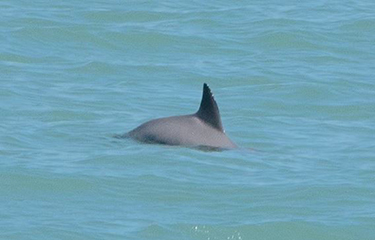Vaquita population remains at critical level at 10 to 13 individuals

The latest survey of the vaquita porpoise population in Mexico’s Upper Gulf of California has placed the current population of the species at 10 to 13 individuals, including one or two calves – level with the most-recent previous estimate from 2021.
The survey was conducted by the International Union for Conservation of Nature (IUCN) Species Survival Commission Cetacean Specialist Group in May 2023 in the gulf of California.
The vaquita population has fallen to critical levels primarily as a result of illegal fishing for shrimp and totoaba, another critically endangered species. Totoaba bladders fetch high prices in China, as they are believed to have health benefits when eaten, and they are similar to the swim bladders of the bahaba – or yellow croaker – another species that is critically endangered due to excessive fishing.
Fishing has been banned in a so-called zero-tolerance area in the northern part of the Gulf of California in an effort to save the vaquita from extinction, but illegal fishing still takes place there. In August 2022, the Mexican Navy deployed 193 concrete blocks in the area, with three-meter-high metal hooks designed to entangle gillnets. Additionally, the Mexican Navy has collaborated with the Sea Shepherd Conservation Society to closely monitor fishing activity, resulting in a 90 percent reduction in gillnetting in the zero-tolerance area, according to the survey.
“The concrete blocks, together with enforcement within the ZTA, seem to constitute an effective way to prevent gillnetting,” the IUCN report said. “Based on this year’s results, expansion of the concrete block-and-hook approach to other areas where vaquitas are known to be feeding is an urgent priority.”
Alex Olivera, the senior Mexico representative with the Center for Biological Diversity, one of three environmental non-governmental organizations that have taken a number of legal actions to compel the U.S. and Mexican governments to take action to preserve the vaquita, called the study “encouraging news”
“It shows that vaquita are survivors. But we still need urgent conservation efforts to save these tiny porpoises from extinction,” Olivera said. “The number of vaquitas may have slightly increased, but this species has low population growth rates. Even in a gillnet-free habitat, it will take about 50 years for the population to return to where it was 15 years ago. Vaquita face an enormous risk of extinction because of the deadly gillnets in their habitat and lack of enforcement by the Mexican government. We need Mexico to urgently comply with existing regulations to prevent the vaquita from disappearing forever.”
On 30 May, a ruling from the U.S. Fish and Wildlife Service that Mexico is not doing enough to protect the vaquita forced U.S. President Joe Biden to make a determination whether to impose an embargo on Mexican imports. That decision will be made by August, according to the White House.
Photo courtesy of IUCN SSC Cetacean Specialist Group






Share